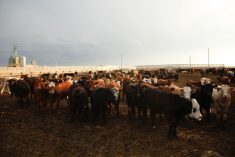Compared to last week, western Canadian feeder cattle prices traded $5 higher to $5 lower; however, yearlings were a solid $2 to $4 lower.
Negative feeding margins over the past month, along with weakness in the deferred live cattle futures, set a negative tone in the heavier weight classes. The calf market appears to be holding value, with a positive outlook for yearlings in the first quarter, but these calf prices also don’t pencil out for the slaughter market next August. Given the current market structure, it appears that the upside momentum has stalled for the time being. Alberta fed cattle prices were reported at $148-$150 last week; break-even pen closeouts are slightly under water by $4-$6.
Read Also

Alberta crop conditions improve: report
Varied precipitation and warm temperatures were generally beneficial for crop development across Alberta during the week ended July 8, according to the latest provincial crop report released July 11.
Favourable weather allowed feedlots to settle and process cattle under optimal conditions. This environment caused unweaned and semi-weaned to gain on fully weaned feeders as the weather risk discount evaporated. Feedlots were once again quite aggressive on larger groups of quality cattle. The Canadian satellite recap in B.C. had 100 steers, including 50 per cent yellow and 50 per cent grey Charolais-cross with a base of 640 lbs., sold for $226. A group of 100 heifers, 75 per cent yellow and 25 per cent grey Charolais-cross with a base weight of 610 lbs., traded for $219.50. When buyers see these types of sales, they tend to set the tone across the Prairies.
Eastern Saskatchewan once again carried a notable premium over major Alberta markets. A small group of mixed tan larger-frame steers just off their mother and weighing just under 520 lbs. sold for $252, a $12 premium over similar-quality feeders in central Alberta.
Feed barley prices have rallied $8-$10 over the past couple of weeks, which has also spurred on additional fears. Rising feed grain prices haven’t influenced the feeder market so far, but additional upside of similar magnitude will put the market on the defensive. At this time of year, feedlot managers can be fussier on price and quality, which makes the market more vulnerable.
— Jerry Klassen manages the Canadian office of Swiss-based grain trader GAP SA Grains and Produits Ltd. and is president and founder of Resilient Capital, specializing in proprietary commodity futures trading and market analysis. Jerry consults with feedlots on risk management and writes a weekly cattle market commentary. He can be reached at 204-504-8339.














